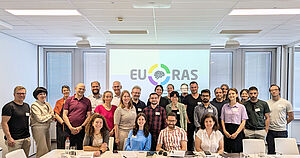The FENS Forum 2024, the largest European conference for neuroscience with over 7000 participants, provided the perfect time to hold the consortium meeting of the EU project EURAS in Vienna. From 1-2 July, the project partners gathered at the AIT in Giefinggasse 4 to discuss the progress made after the first year of the project and the next steps for the following years. The EURAS project focusses on improving the understanding and development of therapies for rasopathies, a group of rare diseases with neurodevelopmental disorders.
What is special about this project is that it was developed with the significant involvement of patient organisations. Basic researchers, clinicians and patient organisations are working together to use the clinical phenotypic data from self-developed registration systems with data from public databases and experimental data generated in the project to ultimately develop personalised therapies for patients suffering from one of the rasopathies being researched (Syngap1, CFC, Costello syndrome). A particular challenge here is that these are rare diseases that lead to diseases of varying severity due to different mutations of the same genes.
The role of the group of Principal Scientist Winfried Neuhaus from the Competence Unit Molecular Diagnostics of the Center for Health and Bioresources is the development of disease-specific models of the blood-brain barrier. PhD student Nikoletta Kardos-Török is specifically investigating whether the blood-brain barrier is altered in these diseases and whether these changes influence the course of the disease. These models are then also used to test therapies and ensure that the selected active substances actually reach their target cells (e.g. nerve cells) in the brain. In order to generate personalised disease models, cells from patients with a known phenotype are reprogrammed into stem cells, which are then used to develop the corresponding blood-brain barrier models.
You can find more detailed information at: https://euras-project.eu/




